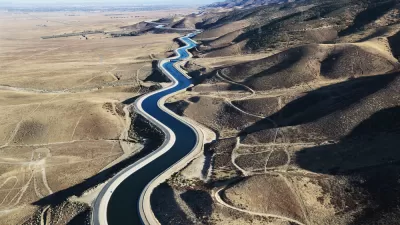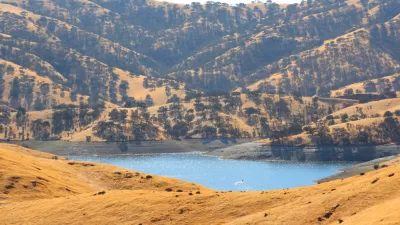A pair of recent stories explores the reemergence of California history, especially it’s gold rush history, as a result of falling water levels around the state.
A historically dry winter is robbing the west’s rivers and lakes of their normal, rejuvenating high winter and spring flows. As water levels drop lower and lower, land is revealed that reveals a prior era of California’s existence.
Richard Chang writes about how low river levels are revealing stretches of river bank that haven’t been mined in “decades, if not over a century.” The newly revealed river beds have sent many hobbyists down to the river to search for gold. So far, no one has struck it rich—except for the business owners selling mining equipment to gold-seeking prospectors.
Jim Carlton writes about the historic towns that have emerged from below shrinking reservoirs in states all over the West. In California, that means places built during the Gold Rush and later covered by the state’s water storage systems are seeing the light of day again for the first time in over 50 years. For instance, “man-made Folsom Lake has receded to less than one-fifth of its capacity amid bone-dry conditions in California, recently revealing outskirts of a ghost town called Mormon Island founded during the mid-19th century gold rush.” Like the prospectors scouring the state’s river beds for gold, the old re-emerged ghost towns have attracted their own scavengers: “On an unseasonably warm winter day recently, throngs of visitors descended on the cracked mud flats of the reservoir to inspect hand-forged nails, rusted hinges and other vestiges of frontier life that were inundated when the lake was created in 1955,” reports Carton.
The rediscovered places are not without their regulatory concerns: “One threat has come from treasure hunters wielding metal detectors, prompting the state agency to hurriedly adopt rules against their use.”
FULL STORY: Drought Provides Window to Old West

Study: Maui’s Plan to Convert Vacation Rentals to Long-Term Housing Could Cause Nearly $1 Billion Economic Loss
The plan would reduce visitor accommodation by 25,% resulting in 1,900 jobs lost.

North Texas Transit Leaders Tout Benefits of TOD for Growing Region
At a summit focused on transit-oriented development, policymakers discussed how North Texas’ expanded light rail system can serve as a tool for economic growth.

Why Should We Subsidize Public Transportation?
Many public transit agencies face financial stress due to rising costs, declining fare revenue, and declining subsidies. Transit advocates must provide a strong business case for increasing public transit funding.

How to Make US Trains Faster
Changes to boarding platforms and a switch to electric trains could improve U.S. passenger rail service without the added cost of high-speed rail.

Columbia’s Revitalized ‘Loop’ Is a Hub for Local Entrepreneurs
A focus on small businesses is helping a commercial corridor in Columbia, Missouri thrive.

Invasive Insect Threatens Minnesota’s Ash Forests
The Emerald Ash Borer is a rapidly spreading invasive pest threatening Minnesota’s ash trees, and homeowners are encouraged to plant diverse replacement species, avoid moving ash firewood, and monitor for signs of infestation.
Urban Design for Planners 1: Software Tools
This six-course series explores essential urban design concepts using open source software and equips planners with the tools they need to participate fully in the urban design process.
Planning for Universal Design
Learn the tools for implementing Universal Design in planning regulations.
City of Santa Clarita
Ascent Environmental
Institute for Housing and Urban Development Studies (IHS)
City of Grandview
Harvard GSD Executive Education
Toledo-Lucas County Plan Commissions
Salt Lake City
NYU Wagner Graduate School of Public Service





























